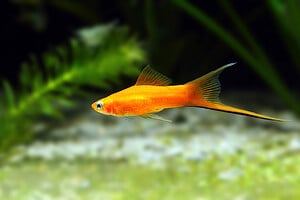Gouramis are types of anabantoid fish that mainly originate from Southeast Asia. They are primarily freshwater and tropical fish that can be found in various colors and sizes. There are currently over 130 different species of gourami belonging to 15 genera and four subfamilies. However, only a handful of these species are kept as pets.
Gouramis can be found both in the wild and in captivity where they are striking additions to aquariums. They are similar to the popular betta fish since they belong in the family and have labyrinth organs that allow them to breathe oxygen from the surface.
Due to the variation in species, they can have different care requirements. This is usually true for their tank size and compatible tank mates, but their water parameters are similar. Caring for gouramis is relatively simple, and they can be a good choice for beginner fish keepers.
Gourami Fish Care Sheet
| Family Name: | Osphonemidae |
| Care Level: | Easy |
| Lifespan: | 3 – 5 years |
| Diet: | Omnivore |
| pH Range: | 6 – 8 |
| Water Hardness: | 4 – 12 dGH |
| Water Temperature: | 72°F – 82°F |
| Ammonia and Nitrite: | 0 ppm |
| Nitrate: | Below 20 ppm |
What Do Gourami Fish Need?
- A spacious rectangular fish tank above 20 gallons in size.
- A filter for their aquarium.
- An aeration system (bubbler, waterfall, or spray bar).
- An aquarium heater because they are tropical fish.
- Live or fake plants for security.
- A sandy or fine gravel-like substrate.
- A group of four or more because they are social fish.
- Optional: compatible tank mates like guppies, Plecostomus, corydoras, and mystery snails.
- A cycled aquarium with no traces of ammonia or nitrite.
1. Honey Gourami
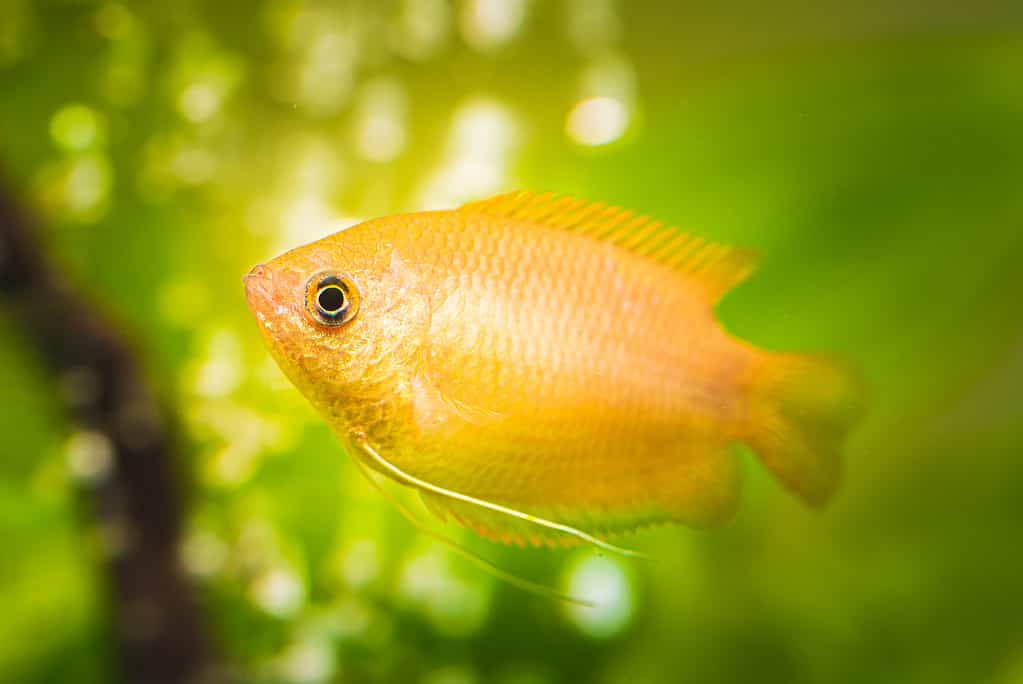
The honey gourami has a striking sunset-orange coloration.
©Przemek Iciak/Shutterstock.com
| Scientific Name: | Trichogaster chuna |
| Origin: | Asia |
| Size: | 2 – 2.5 inches |
The honey or sunset gourami is a brilliantly colored fish originating from Asia, specifically in northern India, Bangladesh, and Nepal. They naturally inhabit slow-moving, heavily planted waters such as ponds, puddles, and flooded fields. They have a peaceful temperament and striking coloration that makes them appealing to both novice and experienced fish keepers.
The honey gourami has a vibrant orangish-yellow coloration with a brown stripe across their lateral line. Honey gourami are relatively small fish that rarely exceed 2.5 inches in size. Their small size makes them easier to house than the larger species. Most honey gourami require a minimum tank size of 25 gallons.
However, if you keep them in community aquariums or in large groups, a tank size of over 40 gallons is recommended. Honey gourami benefits from a heater and filter in their aquarium to keep their water in good condition.
2. Pearl Gourami
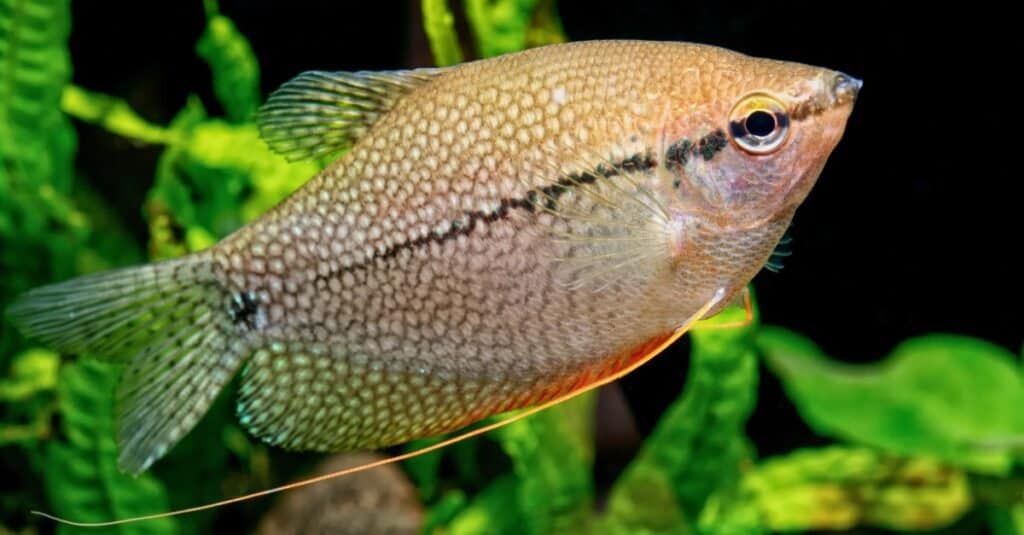
The pearl gourami has a unique peachy color.
©iStock.com/NERYX
| Scientific Name: | Trichopodus leerii |
| Origin: | Southeast Asia |
| Size: | 4 – 5 inches |
The pearl gourami is a peaceful fish that originates from Thailand, Borneo and Sumatra islands, and Malaysia in Southeast Asia. There they inhabit freshwater lowland swamps with dense vegetation and sluggish waters.
The pearl gourami doesn’t get very big at only 5 inches in size as an adult. However, 4 to 4.8 inches is a standard size for them.
Pearl gouramis have a fascinating coloration consisting of a brownish body with a black stripe across the middle of their bodies. They have small white dots that make them shine under bright lighting. Male pearl gouramis often have a reddish-orange coloration along their anal fin and underneath their heads.
Pearl gourami do best in a rectangular fish tank around 30 gallons in size. They can be kept in groups of four or more, with more males than females. They require a heater in their aquarium, along with a filter, sandy substrate, and plenty of live plants.
3. Blue Gourami
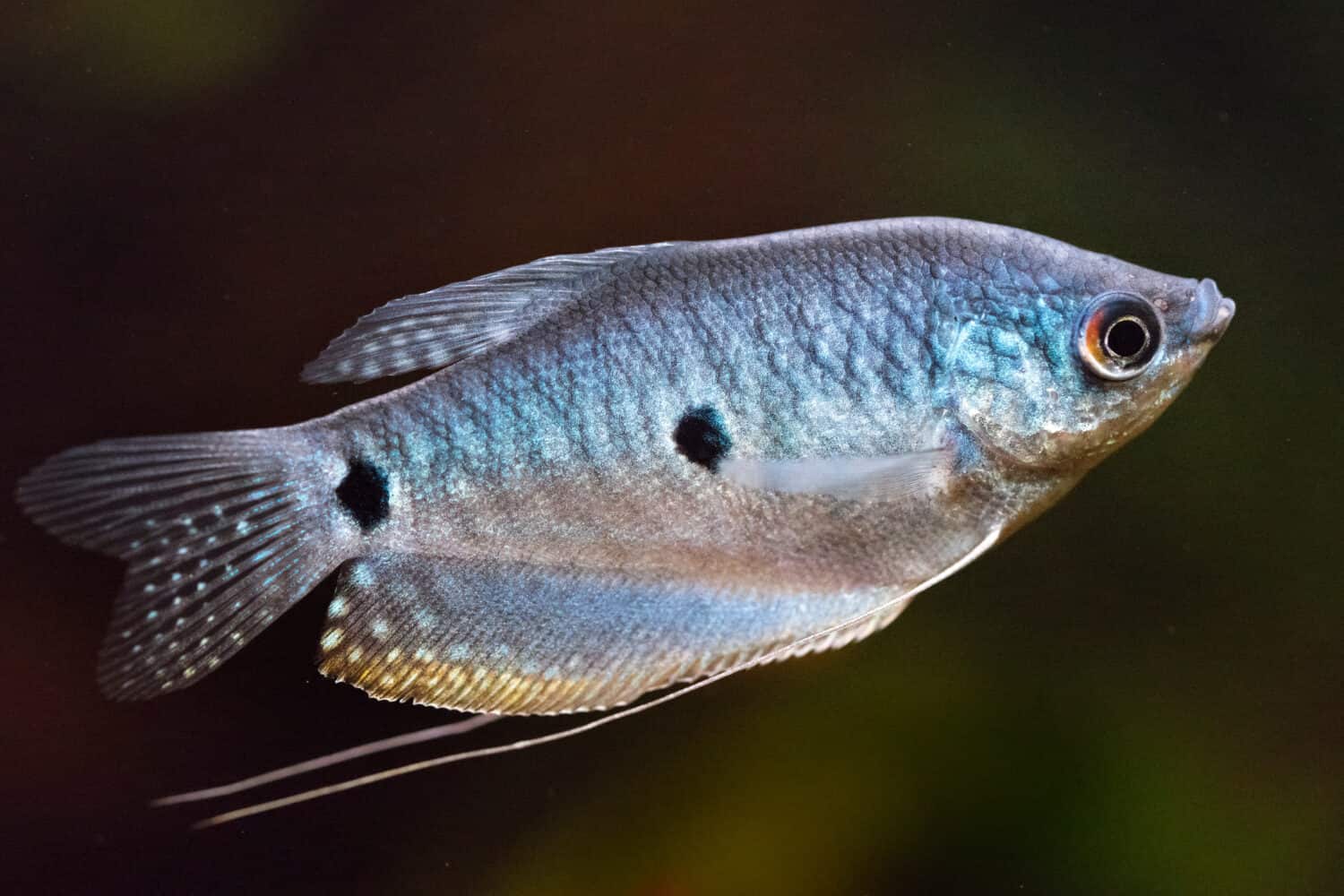
The blue gourami has two distinctive black dots on the sides of their bodies.
©tupulointi/Shutterstock.com
| Scientific Name: | Trichogaster Trichopterus |
| Origin: | Southeast Asia |
| Size: | 5 – 6 inches |
The blue or three-spot gourami is a popular species that is often a top choice for community aquariums. They are peaceful, social, and generally keep to themselves in an aquarium. Blue gouramis originate from the river basins in southern China, Thailand, Cambodia, Vietnam, and Laos. However, they can also be found in Papua New Guinea, the Seychelles Islands, and the Philippines. They prefer to inhabit heavily vegetated lowland waters like marshes, ponds, and swamps with slow-moving waters.
Blue gouramis are medium-sized at around 6 inches as an adult. They have a shiny blue coloration with a distinctive dot at the base of their tail and just before their head. Their fins usually have white dots and a slight reddish tint.
They should be kept in a tank of about 36 gallons in size and can be kept with other compatible tank mates in community aquariums. The blue gourami is quite a hardy and adaptable fish, but they still require good water quality to stay healthy.
4. Croaking Gourami
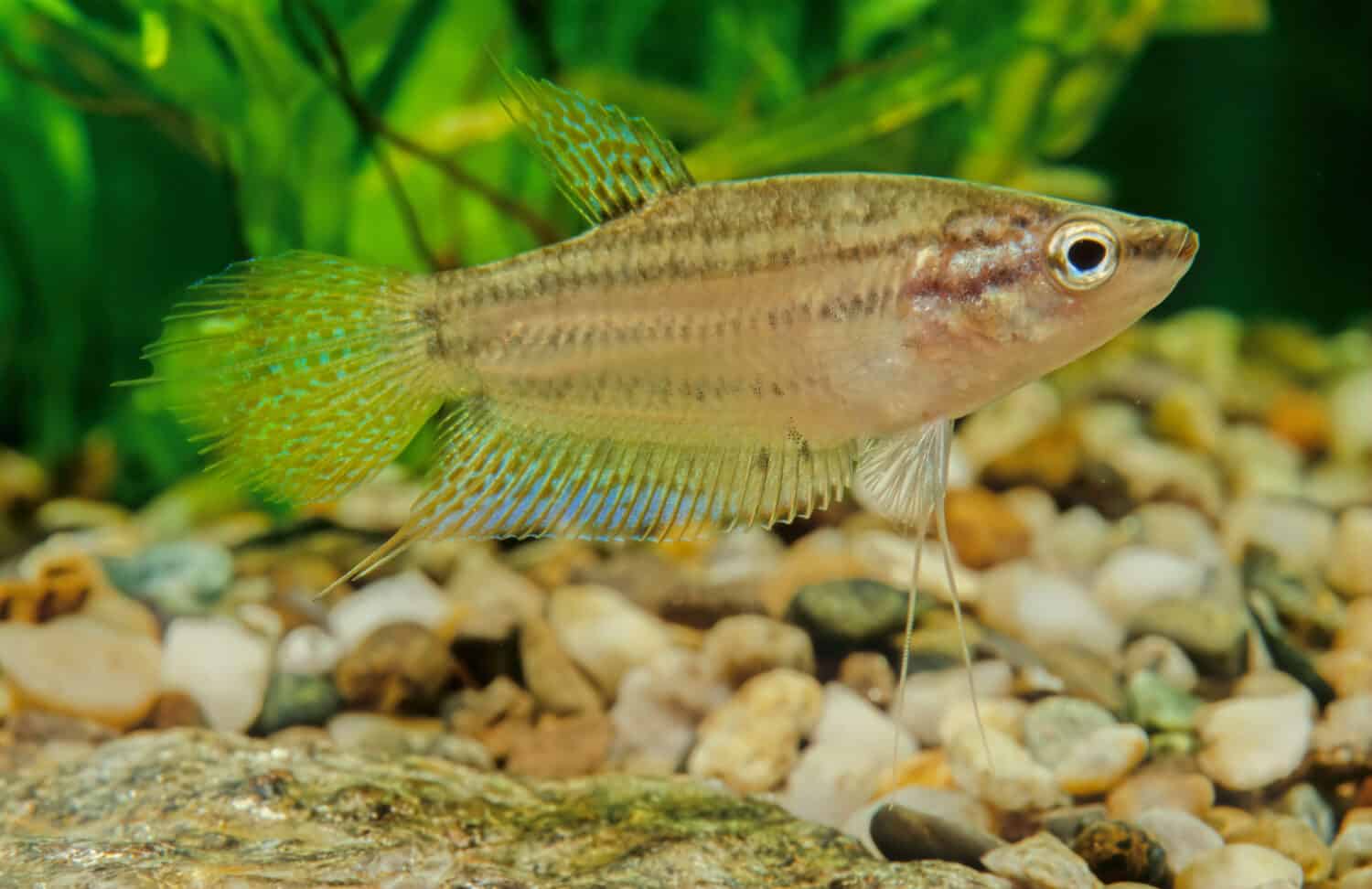
Croaking gourami gets their name from their frog-like vocalizations during the breeding season.
©Roberto Dani/Shutterstock.com
| Scientific Name: | Trichopsis vittata |
| Origin: | Southeast Asia |
| Size: | 2 – 3 inches |
The croaking gourami is an attractive fish with a simple appearance and unusual vocalizations. Croaking gourami naturally inhabits slow-moving waters like ponds, rice paddy fields, and canals in parts of Southeast Asia. Although they don’t have much to offer in terms of their appearance, they still make low-maintenance pet fish.
Croaking gouramis are a dull yellow-brown color with two dark brown lines across their bodies. They rarely grow larger than 3 inches in size, with 2.5 being a standard length.
Croaking gouramis produce a croaking sound from their pectoral fins and muscles, which is often heard during the breeding season. This sounds similar to a frog croak, although it can be inaudible in an aquarium. Due to their small size, croaking gourami can be kept in 25 gallons fish tanks.
5. Moonlight Gourami
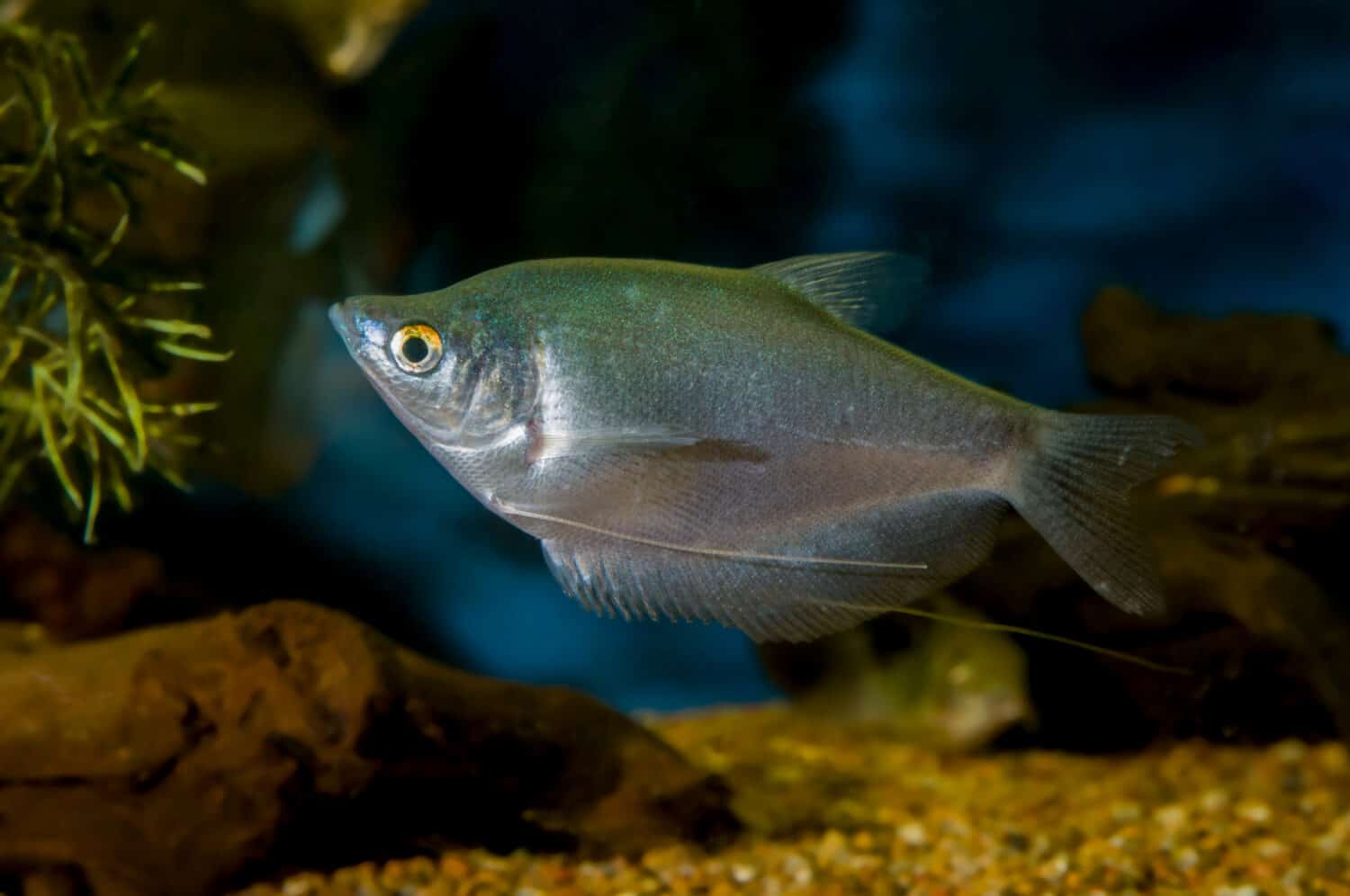
The moonlight gouramis’ iridescent body shimmers under aquarium lighting.
©Michael Siluk/Shutterstock.com
| Scientific Name: | Trichogaster microlepsis |
| Origin: | Indochina |
| Size: | 6 inches |
The moonlight gourami originates from Vietnam, Cambodia, and China. They prefer sluggish ponds, marshes, and swamps filled with plants and muddy substrate. Moonlight gouramis grow to around 6 inches in size, so they require a tank larger than 36 gallons in size.
The moonlight gouramis’ appearance is fascinating and stands out in brightly lit aquariums. They have a blueish-silver iridescent coloration that shimmers. They look spectacular in planted aquariums with a dark substrate and background. Although moonlight gouramis can be kept in community aquariums, they are often shy and might hide more than the other species. Regardless, they still make interesting and peaceful pets.
6. Giant Gourami

The giant gourami can grow up to 24 inches in size and requires very large aquariums.
©Watcharin Tadsana/Shutterstock.com
| Scientific Name: | Osphronemus goramy |
| Origin: | Southeast Asia |
| Size: | 12 – 24 inches |
One of the largest species of gourami is the giant gourami. They are large fish that originate from Indonesia, Thailand, and Malaysia in Southeast Asia. Their size can distinguish the giant gourami at 12 to 24 inches as an adult. Giant gouramis get much larger than other species, so they have different tank size requirements.
A single or pair of Giant gouramis require at least a 150-gallon aquarium. They are a poor choice for small or community aquariums and take up a lot of space. Unfortunately, they are not a good choice for new fish keepers as their care requirements are more suitable for experienced fish keepers.
Giant gouramis need a large aquarium heater to maintain a comfortable water temperature between 72 to 80 degrees Fahrenheit. A large filter is also necessary, but it shouldn’t produce a strong flow. Giant gourami do not enjoy swimming against a current in their aquariums since they originate from slow-moving waters.
7. Dwarf Gourami
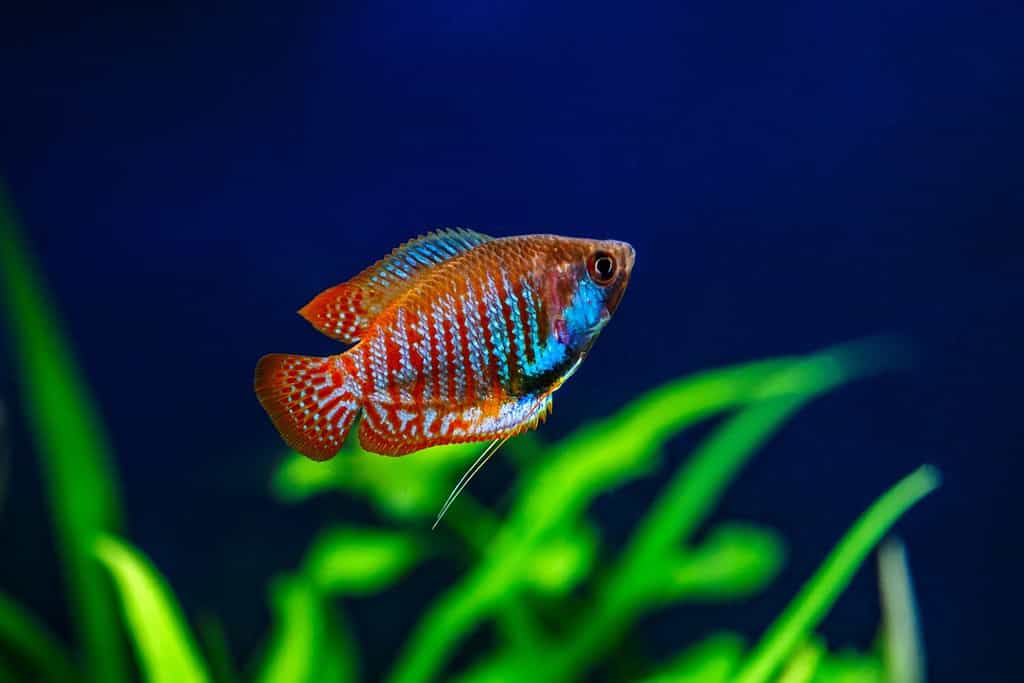
Dwarf gourami can be found in a range of different colors.
©Bukhta Yurii/Shutterstock.com
| Scientific Name: | Trichogaster lalius |
| Origin: | Bangladesh, India |
| Size: | 3.5 – 4.5 inches |
The dwarf gourami is a small and colorful species originating from India and Bangladesh. They are vibrantly colored with a mixture of blues, reds, oranges, and stripes. The dwarf gourami rarely grows larger than 4.5 inches, although 4 inches is a standard length for these fish. In the wild, dwarf gourami inhabits tropical and heavily vegetated wetlands, flood forests, and sluggish rivers. They are peaceful and social fish, but males can become semi-aggressive during the breeding season.
Due to their relatively small size, dwarf gourami can be kept in aquariums around 30 gallons in size. Their peaceful and social temperament often makes them a good choice for community aquariums. However, they should not be housed with large or aggressive fish, since they are vulnerable to being bullied or injured.
8. Licorice Gourami

Female licorice gourami has a duller coloration than males.
©boban_nz/Shutterstock.com
| Scientific Name: | Parasphronmenus deissneri |
| Origin: | Southeast Asia |
| Size: | 2.5 – 3 inches |
The licorice gourami originates from Southeast Asia where they inhabit warm jungle streams and swamps with dense vegetation. Their natural habitat has a lot of tannins in it, giving the water a yellow tint. Tannins are often preferred for licorice gourami aquariums, which you can achieve by adding Catappa leaves or decaffeinated Rooibos tea bags.
Licorice gouramis stand out with their fascinating appearance. They have a combination of vivid greens, blues, and reds with a spade or half-moon-shaped tail. Licorice gouramis happen to be one of the most colorful gouramis that you can add to your aquarium. They only grow to around 3 inches in size and can be kept in 25-gallon aquariums.
9. Kissing Gourami
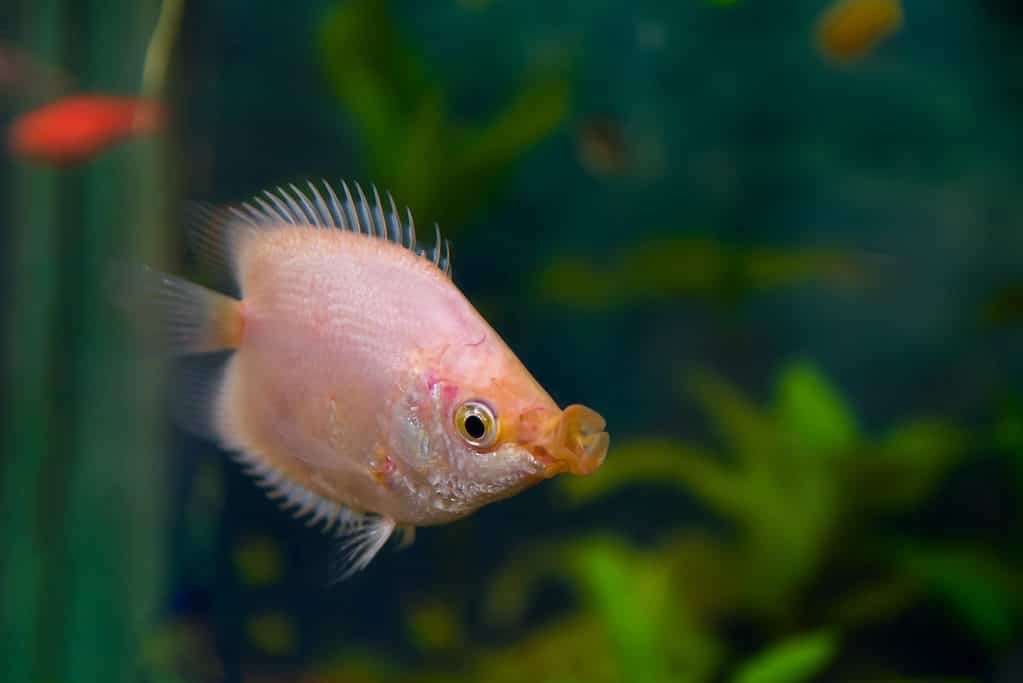
The kissing gourami is one of the most distinct species in the gourami family.
©Evgenii Predybailo/Shutterstock.com
| Scientific Name: | Helostoma temminckii |
| Origin: | Southeast Asia, Indonesia, Greater Sundas |
| Size: | 8 – 12 inches |
The kissing gourami has distinctive pouting lips that they use to scrape algae from flat surfaces or connect to other males to establish dominance. They originate from Southeast Asia where they inhabit tropical, slow-moving waters. In some cases, kissing gourami are also farmed as a source of food. They are the only member of the Helostomatidae family.
Kissing gourami can grow fairly large between 8 to 12 inches in size. They have a simple yet striking appearance that consists of a pinkish-blue iridescent coloration. Most kissing gourami can exceed the typical lifespan of other gourami species. With proper care, the kissing gourami has an average lifespan of 5 to 7 years.
Due to the kissing gouramis’ large size, they are better suited for very large aquariums. They are a great choice for experienced fish keepers who can keep them in tanks no smaller than 75 gallons in size. However, a 120-gallon tank is ideal for kissing gouramis over 10 inches in size.
10. Sparkling Gourami
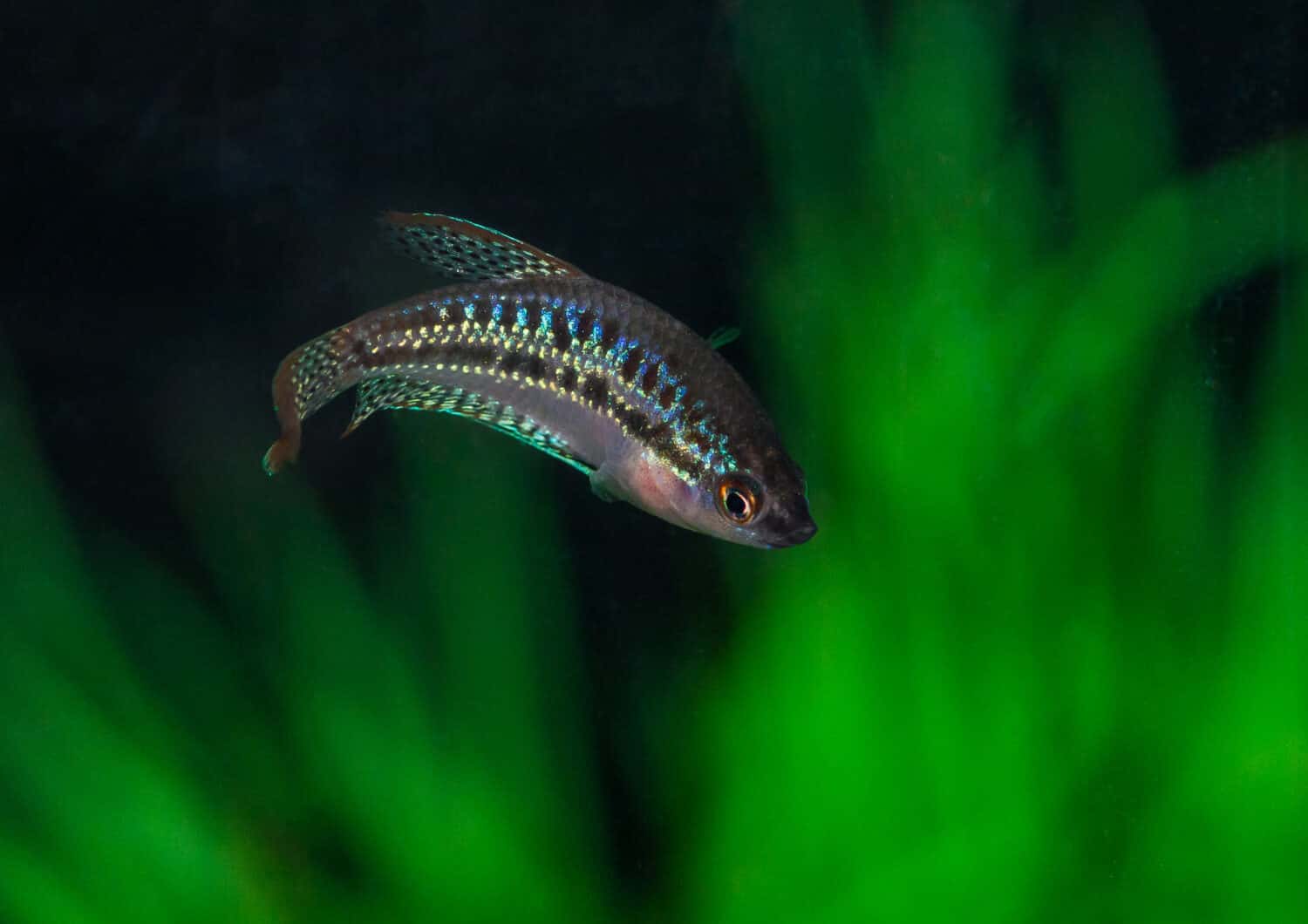
The sparkling gourami is one of the smallest species of gourami fish.
©Ian Grainger/Shutterstock.com
| Scientific Name: | Trichopsis pumila |
| Origin: | Southeast Asia |
| Size: | 1.5 – 2 inches |
Last on our list is the fascinating sparkling gourami. Sparking gourami originate from Southeast Asia, specifically the Mekong River basin in Laos, Thailand, Cambodia, and Vietnam. They can be found in slow-moving tropical waters such as canals, paddy fields, floodplains, and even roadside ditches. They are among one of the smallest species of gourami, reaching a size of 1.5 to 2 inches as an adult.
Sparkling gourami are both social and peaceful fish that can be kept in community aquariums or in small groups. Their small size makes them able to live in 25-gallon tanks, but you might be able to keep juveniles in 20-gallon tanks. You ideally want to ensure that their tank is heavily planted since sparkling gouramis can become shy when they are kept in barren aquariums with few hiding places.
Breeding Gourami
Like the fellow betta fish, gouramis are bubble nest builders. They have interesting breeding habits that are sometimes shocking to new fish keepers. Gouramis will build a foamy bubble nest along the surface of the water. When they are ready to breed at around one year of age, the males and females engage in a spawning ritual. The male will chase and swim around the female before contorting his body around her to squeeze out her eggs.
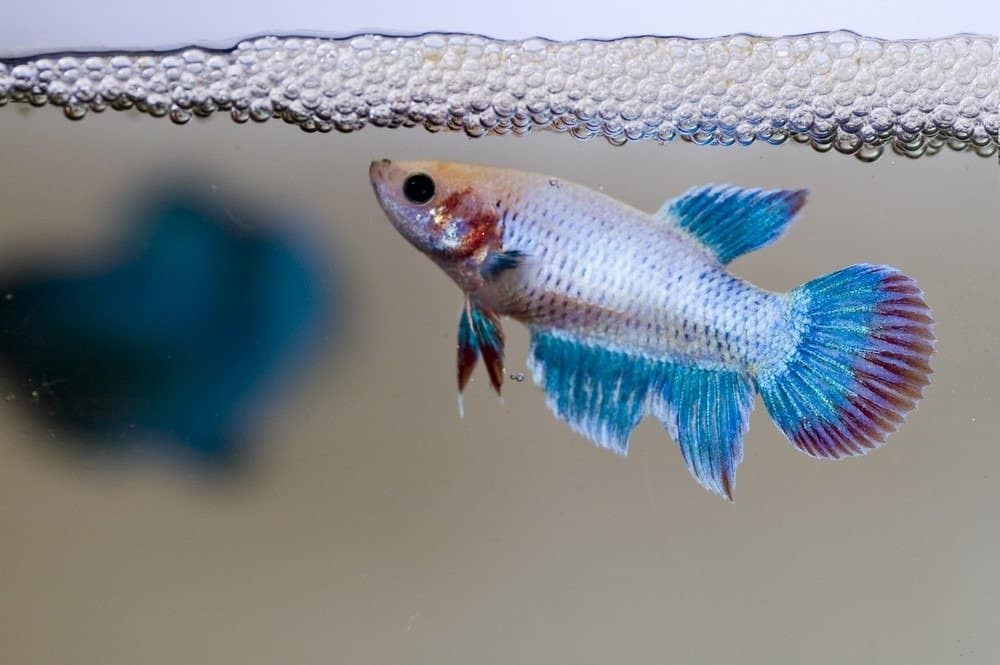
Like bettas, gourami creates a foamy bubble nest at the surface of the water.
©mnoor/Shutterstock.com
Once she has deposited her eggs, the male gourami will scoop them up into his mouth and carefully place them into the bubble nest. He will protect the eggs until they hatch in one to three days. The fry (baby fish) will be free swimming and don’t receive any parental care. They should ideally be moved to a separate tank, since adult gourami may cannibalize their offspring.
In Summary: The 10 Types of Gourami Fish
| Rank | Type of Gourami |
|---|---|
| 1. | Honey gourami |
| 2. | Pearl gourami |
| 3. | Blue gourami |
| 4. | Croaking gourami |
| 5. | Moonlight gourami |
| 6. | Giant gourami |
| 7. | Dwarf gourami |
| 8. | Licorice gourami |
| 9. | Kissing gourami |
| 10. | Sparkling gourami |
The photo featured at the top of this post is ©
Thank you for reading! Have some feedback for us? Contact the AZ Animals editorial team.




